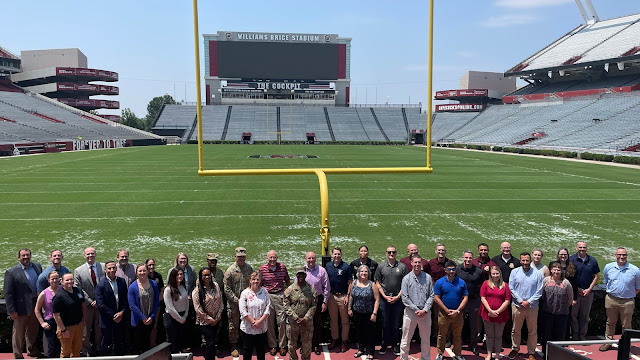Inaugural Department of Defense-Wide Bone Stress Injury Symposium Addresses Critical Military Health Issue
The Uniformed Services University’s Musculoskeletal Injury Rehabilitation Research for Operational Readiness (MIRROR) program recently presented the inaugural Department of Defense-wide Bone Stress Injury (BSI) Symposium.
October 12, 2023 by Zachary Willis
The Uniformed Services University’s Musculoskeletal Injury Rehabilitation Research for Operational Readiness (MIRROR) program recently presented the inaugural Department of Defense-wide Bone Stress Injury (BSI) Symposium. This two-day event, which took place on June 8-9, at the University of South Carolina, was held in collaboration with the U.S. Army Training Center/Fort Jackson, S.C., Moncrief Army Hospital at Fort Jackson, the U.S. Army Research Institute of Environmental Medicine in Natick, Mass., The Geneva Foundation, and Prisma Health. The symposium attracted a diverse audience of more than 130 attendees, both in-person and virtually, to address the critical issue of stress fractures among military personnel.
Bone Stress Injuries have long been a persistent challenge within the military. The prevalence of BSIs is a cause for significant concern, with statistics revealing that 7% of men and a staggering 20% of women sustain a BSI during their initial military training. These injuries can be particularly debilitating, causing structural fatigue and severe pain, both of which can adversely impact military readiness.
The symposium’s primary objective was to lay the foundation for a collaborative BSI working group. Attendees engaged in discussions about the pressing need for a dedicated team of experts to tackle the complex, multi-faceted issue of BSI. The symposium's main objectives included establishing a blueprint to foster strong bone health in soldiers and mitigate the threat of BSI to military readiness, creating a network of partners with expertise across various domains, and ensuring the necessary leadership, resources, and physical infrastructure to support research and educational efforts.
 |
| (Photo courtesy of MIRROR) |
Symposium attendees constituted a diverse range of professionals deeply committed to addressing this issue. They included clinical researchers, research scientists, physical therapists, and athletic trainers from the Defense Health Agency, military treatment facilities, and academic institutions.
The conference showcased 15 speakers, with Dr. Brad Isaacson, Chief of Research and Operations for the MIRROR program, providing an overview of MIRROR's work. Isaacson highlighted a groundbreaking study titled "Utilizing Photobiomodulation Therapy for the Treatment of Lower Extremity Stress Fractures in a Military Training Setting." This innovative study aims to assess the effectiveness of photobiomodulation therapy as a complementary treatment for tibial and metatarsal stress fractures during military training.
One of the defining features of the event was its strong emphasis on audience interaction. Following each presentation, a 10-minute question and answer session promoted meaningful discussions. Additionally, a BSI SWOT analysis discussion with subject matter experts was held, along with a panel discussion. Army Brig. Gen. Jason Kelly, commanding general of the U.S. Army Training Center and Fort Jackson, concluded the symposium with remarks emphasizing the significance and importance of BSI research and education.
“This inaugural Department of Defense-wide Bone Stress Injury Symposium served as a valuable platform to address a critically important military health-related issue that has significant implications for military readiness. It also greatly fostered meaningful collaboration among experts in the field,” said Dr. Paul Pasquina, chair of USU’s Department of Physical Medicine and Rehabilitation, which houses the MIRROR program. “It marks an important step towards the improved prevention and treatment of service members with bone stress-related injuries.”


